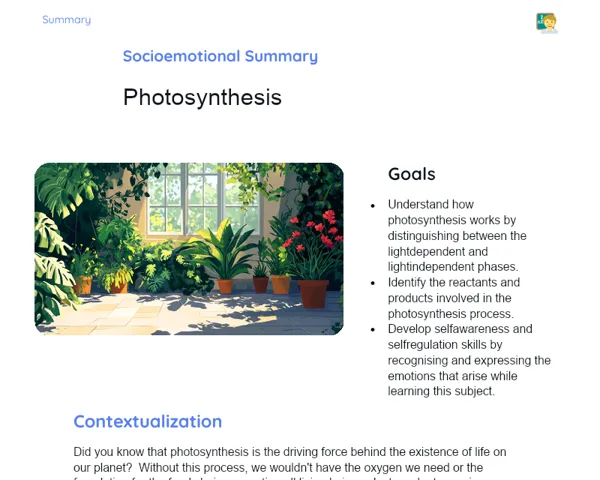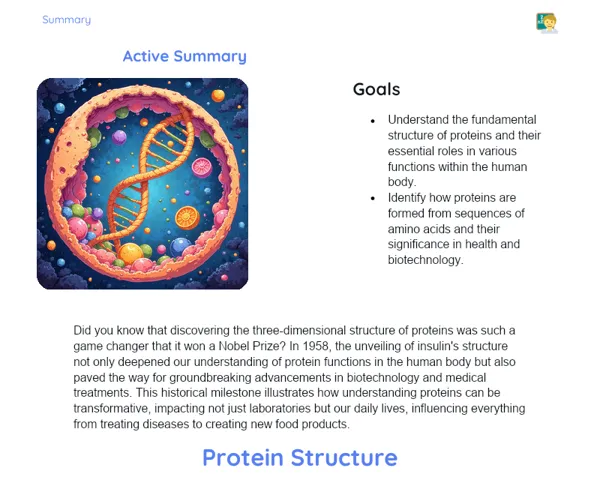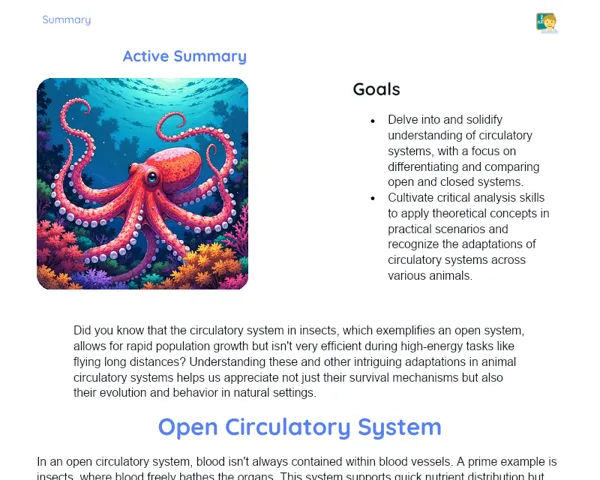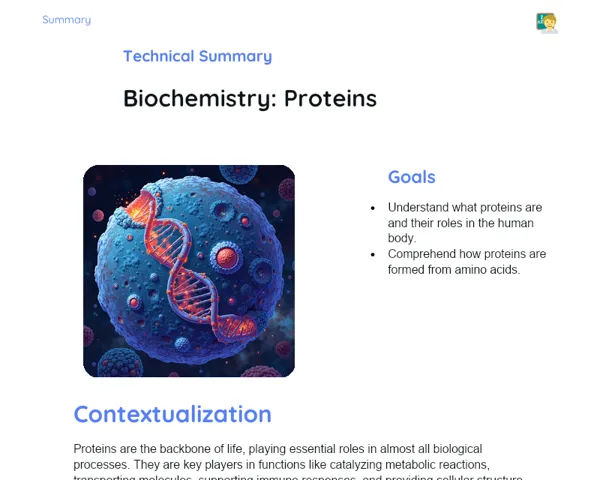Summary Tradisional | Chromosomes
Contextualization
Chromosomes are vital components found in the nucleus of eukaryotic cells and play a key role in genetic inheritance. They are made up of long strands of DNA wrapped around proteins known as histones. Chromosomes are responsible for storing and neatly organizing the genetic material that dictates the inherited traits of living beings. The discovery of chromosomes marked a groundbreaking moment in cell biology, with scientists like Walther Flemming first describing these formations in 1879, which greatly enriched our understanding of genetics and molecular biology.
Besides their core role in organizing DNA, chromosomes are crucial for cell division—a process necessary for growth, development, and maintenance of organisms. During cell division, chromosomes ensure that each daughter cell receives the correct and complete copy of genetic material, thus preventing genetic abnormalities. A full understanding of chromosomes is not just vital for cell biology and genetics, but also for practical medical applications, including diagnosing and treating genetic disorders stemming from chromosomal anomalies.
To Remember!
Definition and Structure of Chromosomes
Chromosomes are intricate structures formed from DNA and proteins called histones. In the nucleus of eukaryotic cells, the DNA is coiled around these histones to create something known as chromatin. This chromatin is then further compacted to form chromosomes, which become particularly visible during cell division. This organization is crucial for effective genetic material storage and accessible processes like transcription and DNA replication.
The structure of chromosomes is highly organized and can be segmented into various distinct regions. Each chromosome features a centromere, a narrowed area that plays a vital role in cell division by anchoring the mitotic spindle fibers. The ends of chromosomes are protected by structures called telomeres, which safeguard genetic information from degradation. The presence of these specific regions is essential for ensuring the stability and integrity of chromosomes throughout the cell cycle.
Moreover, chromosomes contain loci, which are specific spots along the DNA where genes reside. Each gene holds the necessary information for protein synthesis, crucial for performing vital functions in the organism. The arrangement of genes within chromosomes is systematic and can affect how gene expression is regulated. Therefore, chromosome structure not only assists in compacting DNA but is also fundamental for its genetic functionality.
-
Chromosomes are composed of DNA and histones.
-
They feature designated regions such as centromeres and telomeres.
-
They include loci where genes responsible for protein synthesis are situated.
Types of Chromosomes
Chromosomes are primarily categorized into two types: autosomes and sex chromosomes. Autosomes are all chromosomes that do not determine an individual’s sex. In humans, there are 22 pairs of autosomes, making up a total of 44 chromosomes. Each pair of autosomes is numbered from 1 to 22 and consists of genes that dictate various traits unrelated to sex, like eye color, height, and blood type.
Conversely, sex chromosomes are responsible for determining the biological sex of the individual. In humans, there are two types: the X chromosome and the Y chromosome. Females have two X chromosomes (XX), while males possess one X chromosome and one Y chromosome (XY). The presence of the Y chromosome is crucial for the development of male traits. Additionally, sex chromosomes carry genes that affect other biological processes beyond just sex determination.
Distinguishing between autosomes and sex chromosomes is essential for understanding various genetic disorders. Some conditions stem from anomalies in the autosomes, while others arise from irregularities in the sex chromosomes. For instance, Down syndrome results from a trisomy of chromosome 21, an autosome, whereas Turner syndrome, affecting only females, is linked to the complete or partial absence of an X chromosome.
-
Autosomes are not involved in determining sex.
-
Sex chromosomes dictate biological sex (XX in females, XY in males).
-
Abnormalities in chromosomes can lead to genetic disorders.
Function and Importance of Chromosomes
Chromosomes are crucial for cell division, an indispensable process for the growth, development, and upkeep of living organisms. During mitosis, chromosomes are duplicated and meticulously distributed among daughter cells, ensuring that each new cell inherits a full set of genetic material. This is fundamental for tissue regeneration and replacing damaged or aging cells.
Beyond mitosis, chromosomes also play a role in meiosis, a specialized cell division occurring in germ cells, leading to the creation of gametes (sperm and eggs). In meiosis, chromosomes undergo genetic recombination, a mechanism that enhances genetic variation by mixing maternal and paternal genes. Such variability is essential for the evolution and adaptability of species.
Chromosomes not only guarantee the correct distribution of DNA during cell division but also regulate gene expression. The compactness and arrangement of chromosomes determine which genes are activated or silenced, enabling cells to respond effectively to both internal and external cues. Thus, chromosomes are indispensable for maintaining balance and orchestrating complex biological functions.
-
Chromosomes are vital for both mitosis and meiosis.
-
They ensure accurate distribution of genetic material.
-
They play a key role in genetic variation and regulating gene expression.
Chromosomal Alterations and Genetic Diseases
Changes in the number or structure of chromosomes can lead to various genetic disorders. Numerical chromosomal abnormalities, such as trisomies and monosomies, arise when there is an atypical number of chromosomes. A well-known example is Down syndrome, which is caused by having three copies of chromosome 21. Individuals with Down syndrome present with distinct physical characteristics and developmental delays.
Apart from numerical anomalies, structural alterations of chromosomes can also lead to genetic diseases. These changes may include deletions (loss of chromosomal segments), duplications (extra segments), inversions (rearranged segments), and translocations (segments switched between chromosomes). Each structural alteration can impact the organism differently based on the affected genes. For instance, Cri-du-Chat syndrome is caused by a deletion in the short arm of chromosome 5, leading to a unique cry resembling a cat's mew and other developmental challenges.
Identifying and understanding chromosomal alterations is essential in modern medicine. Techniques like karyotyping and microarray analysis help in detecting chromosomal anomalies in patients, facilitating early diagnosis and timely intervention. Furthermore, advances in genetic research continue to provide fresh insights into the treatment and prevention of genetic disorders caused by chromosomal alterations.
-
Chromosomal anomalies can be numerical (trisomies, monosomies) or structural (deletions, duplications, inversions, translocations).
-
Down syndrome exemplifies a trisomy (chromosome 21).
-
Timely diagnosis and intervention are crucial for managing genetic disorders.
Key Terms
-
Chromosomes: Structures made of DNA and proteins responsible for storing and organizing genetic material.
-
Histones: Proteins that DNA wraps around to form chromatin.
-
Chromatin: A DNA-protein complex that makes up chromosomes.
-
Centromere: The constricted area of the chromosome anchoring the mitotic spindle fibers during cell division.
-
Telomeres: Protective structures at the ends of chromosomes to preserve genetic information.
-
Autosomes: Chromosomes unrelated to sex determination.
-
Sex Chromosomes: Chromosomes that define biological sex (XX for females, XY for males).
-
Mitosis: The process of cell division generating two identical daughter cells.
-
Meiosis: The process of cell division that produces gametes with half the chromosome number.
-
Trisomy: The presence of three copies of a chromosome instead of the normal two.
-
Deletion: The loss of a segment of a chromosome.
-
Duplication: An extra segment of a chromosome present.
-
Inversion: A rearranged segment of a chromosome.
-
Translocation: A segment that has been swapped between chromosomes.
Important Conclusions
Chromosomes are fundamental structures residing within the nucleus of eukaryotic cells, composed of DNA and histone proteins, responsible for organizing and storing genetic information. Their structure—incorporating centromeres and telomeres—is essential for proper cell functioning and division. Moreover, the compaction of chromatin allows for the regulation of gene expression, ensuring that cells respond effectively to both internal and external stimuli.
Chromosomes can be divided into autosomes and sex chromosomes, each serving distinct functions in determining genetic and sexual characteristics. Changes in the number or structure of chromosomes may lead to genetic disorders like Down syndrome, which arises from a trisomy of chromosome 21. Grasping these abnormalities is pivotal for diagnosing and treating various genetic conditions.
The significance of studying chromosomes reaches beyond cell biology and genetics, influencing fields like medicine and biotechnology. Understanding chromosome organization and function is key for advancements in the diagnosis and management of genetic disorders, as well as for research into genetic variability and evolution. I encourage students to delve deeper into this topic to enrich their knowledge and apply it practically in scientific fields.
Study Tips
-
Use diagrams and illustrative models to visualize chromosome structure and function for better understanding.
-
Explore scientific literature on genetic diseases caused by chromosomal changes to appreciate the practical implications of the topic.
-
Practice solving genetics and cell division problems, focusing on identifying and explaining various types of chromosomal anomalies.



